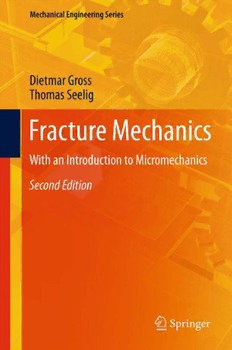
Fracture Mechanics With an Introduction to Micromechanics (Mechanical Engineering) PDF
Preview Fracture Mechanics With an Introduction to Micromechanics (Mechanical Engineering)
Mechanical Engineering Series Frederick F. Ling Editor-in-Chief For further volumes: http://www.springer.com/series/1161 Dietmar Gross • Thomas Seelig Fracture Mechanics With an Introduction to Micromechanics Second Edition Prof. Dr.-Ing. Dietmar Gross Prof. Dr.-Ing. Thomas Seelig Division of Solid Mechanics Institute of Mechanics TU Darmstadt Karlsruhe University (KIT) Hochschulstrasse 1 Kaiserstrasse 12 D-64289 Darmstadt D-76131 Karlsruhe Germany Germany [email protected] [email protected] ISSN 0941-5122 e-ISSN 2192-063X ISBN978-3-642-19239-5 e-ISBN978-3-642-19240-1 DOI10.1007/978-3-642-19240-1 Springer Heidelberg Dordrecht London New York Library of Congress Control Number: 2011932493 © Springer-VerlagBerlinHeidelberg2011 This work is subject to copyright. All rights are reserved, whether the whole or part of the material is concerned, specifically the rights of translation, reprinting, reuse of illustrations, recitation, broadcasting, rep roduction on microfilm or in any other way, and storage in data banks. Duplication of this publication or parts thereof is permitted only under the provisions of the German Copyright Law of September 9, 1965, in its current version, and permission for use must always be obtained from Springer. Violations are liable to prosecution under the German Copyright Law. The use of general descriptive names, registered names, trademarks, etc. in this publication does not imply, even in the absence of a specific statement, that such names are exempt from the relevant protective laws and regulations and therefore free for general use. Cover design: SPi Publisher Services Printedonacid-freepaper SpringerispartofSpringerScience+BusinessMedia(www.springer.com) Preface This book has evolved from lectures on fracture mechanics and micromechanics whichweheldforstudentsofengineeringandnaturalsciencesovertheyears.Itis primarily meant as an aid for students learning the foundationsof these subjects. At the same time this book may also serve as an introductioninto these fields for researchersandpractitionersinindustryandtoprovidethetheoreticalbackground forsolvingrespectiveproblems. The book covers the most important areas of fracture mechanics and gives an introductionintomicromechanics.Ourmajorconcernwasthepresentationofprin- cipalconceptsandmethodsinaclearandsoundmannerasabasisforadeeperentry into the matter. The presentation mainly focuseson the mechanicaldescription of fractureprocesses;yet,materialspecificaspectsarealsodiscussed.Tokeepthetext self-contained,continuummechanicalandphenomenologicalfoundationsarereca- pitulatedfirst. Theyarefollowedbyabriefsurveyofclassicalfractureandfailure hypotheses. A major part of the book is devoted to linear fracture mechanics and elastic-plasticfracturemechanics.Furtherchaptersdealwithcreepfractureanddy- namicfracturemechanics.Anextensivechaptertreatsfoundationsofmicromechan- ics and homogenization.Finally, elements of damage mechanicsand probabilistic fracture mechanics are presented. Suggestionsfor further reading are listed at the endofeachchapter. Thefirsteditionwas wellacceptedbythereadersmakinga neweditionneces- sary.Wehaveusedthischancetoincorporateanumberofextensionswhichpartly are influencedby new developmentsin the field of fracture mechanics.Discussed are, among others, the crack initiation at notches, cohesive zone models, the peel test, fragmentation, and strain localization due to damage and material softening. Furthermore,followingsuggestionsfrommanystudents, supplementaryexamples havebeenaddedasproblemsattheendofsomechapters. The authors are indebted to all who have contributed to this book. This par- ticularly includes those from whom we have learned or, as Roda Roda has put it ironically:“Copyingfromfourbooksyieldsafifthprofoundbook”.Specialthanks go to Mrs. Dipl.-Ing.H. Herbstwhohaspreparedmostof the figures.Finally,the pleasantcooperationwiththepublisherisgratefullyacknowledged. DarmstadtandKarlsruheinJune2011, DietmarGross ThomasSeelig v Contents Introduction ....................................................... 1 1 Elementsofsolidmechanics..................................... 5 1.1 Stress .................................................... 5 1.1.1 Stressvector ........................................ 5 1.1.2 Stresstensor ........................................ 7 1.1.3 Equilibriumconditions ............................... 10 1.2 Deformationandstrain...................................... 11 1.2.1 Straintensor ........................................ 11 1.2.2 Strainrate .......................................... 13 1.3 Constitutivelaws........................................... 14 1.3.1 Elasticity ........................................... 15 1.3.2 Viscoelasticity....................................... 19 1.3.3 Plasticity ........................................... 22 1.4 Energyprinciples........................................... 27 1.4.1 Energybalance ...................................... 27 1.4.2 Principleofvirtualwork .............................. 28 1.4.3 TheoremsofClapeyronandBetti....................... 30 1.5 Planeproblems ............................................ 31 1.5.1 Planestress,planestrain,longitudinalshear .............. 31 1.5.2 Linearelasticity,complexmethod ...................... 33 1.5.3 Perfectlyplasticmaterial,slip-linefields................. 35 1.6 Furtherreading ............................................ 38 2 Classicalfractureandfailurehypotheses.......................... 39 2.1 Basicconcepts............................................. 39 2.2 Failurehypotheses.......................................... 41 2.2.1 Principalstresshypothesis............................. 41 2.2.2 Principalstrainhypothesis............................. 42 2.2.3 Strainenergyhypothesis .............................. 42 2.2.4 Coulomb-Mohrhypothesis ............................ 43 vii viii Contents 2.2.5 Drucker-Pragerhypothesis ............................ 46 2.2.6 Johnson-Cookcriterion ............................... 47 2.3 Deformationbehaviorduringfailure........................... 48 2.4 Problems ................................................. 49 2.5 Furtherreading ............................................ 49 3 Microandmacrophenomenaoffracture ......................... 51 3.1 Microscopicaspects ........................................ 51 3.1.1 Surfaceenergy,theoreticalstrength ..................... 51 3.1.2 Microstructureanddefects ............................ 53 3.1.3 Crackformation ..................................... 56 3.1.4 Percolation ......................................... 57 3.2 Macroscopicaspects ........................................ 59 3.2.1 Crackgrowth........................................ 59 3.2.2 Typesoffracture..................................... 60 3.3 Furtherreading ............................................ 61 4 Linearfracturemechanics ...................................... 63 4.1 Generalremarks ........................................... 63 4.2 Crack-tipfield ............................................. 64 4.2.1 Two-dimensionalcrack-tipfields ....................... 64 4.2.2 Mode-Icrack-tipfield ................................ 70 4.2.3 Three-dimensionalcrack-tipfield....................... 71 4.3 K-concept ................................................ 72 4.4 K-factors ................................................. 73 4.4.1 Examples........................................... 74 4.4.2 Integralequationformulation .......................... 80 4.4.3 Methodofweightfunctions ........................... 82 4.4.4 Crackinteraction .................................... 85 4.4.5 Stressintensityfactorsandstressconcentrationfactors..... 90 4.5 FracturetoughnessK ..................................... 92 Ic 4.6 Energybalance ............................................ 94 4.6.1 Energyreleaseduringcrackpropagation................. 94 4.6.2 Energyreleaserate................................... 96 4.6.3 Compliance,energyreleaserate,andK-factors........... 99 4.6.4 Energybalance,Griffith’sfracturecriterion ..............100 4.6.5 J−integral..........................................106 4.7 Small-scaleyielding ........................................113 4.7.1 Plasticzonesize,Irwin’scracklengthcorrection..........113 4.7.2 Qualitativeremarksontheplasticzone ..................115 4.8 Stablecrackgrowth.........................................116 4.9 Mixed-modeloading........................................119 4.10 Crackinitiationatcavitiesandnotches.........................124 4.11 Fatiguecrackgrowth........................................126 4.12 Interfacecracks ............................................128 Contents ix 4.13 Piezoelectricmaterials ......................................136 4.13.1 Basicprinciples .....................................136 4.13.2 Thecrackinaferroelectricmaterial.....................138 4.14 Problems .................................................140 4.15 Furtherreading ............................................143 5 Elastic-plasticfracturemechanics................................145 5.1 Introduction ...............................................145 5.2 Dugdalemodel.............................................146 5.3 Cohesivezonemodels.......................................150 5.4 Crack-tipfield .............................................153 5.4.1 Perfectlyplasticmaterial..............................153 5.4.2 Totalstraintheory,HRR−field.........................159 5.5 Fracturecriterion...........................................164 5.6 DeterminationofJ .........................................166 5.7 DeterminationofJ ........................................167 c 5.8 Crackpropagation..........................................171 5.8.1 J–controlledcrackgrowth ............................171 5.8.2 Stablecrackgrowth ..................................173 5.8.3 Steady-statecrackgrowth .............................175 5.9 Essentialworkoffracture....................................181 5.10 Problems .................................................183 5.11 Furtherreading ............................................184 6 Creepfracture.................................................185 6.1 Introduction ...............................................185 6.2 Fractureoflinearviscoelasticmaterials ........................186 6.2.1 Crack-tipfield,elastic-viscoelasticanalogy ..............186 6.2.2 Fractureconcept.....................................188 6.2.3 Crackpropagation ...................................190 6.3 Creepfractureofnonlinearmaterials ..........................194 6.3.1 Secondarycreep,constitutivelaw.......................194 6.3.2 Stationarycrack,crack-tipfield,loadingparameters .......195 6.3.3 Creepcrackgrowth ..................................199 6.4 Furtherreading ............................................204 7 Dynamicfracturemechanics ....................................207 7.1 Introduction ...............................................207 7.2 Somefoundationsofelastodynamics ..........................208 7.3 Dynamicloadingofastationarycrack .........................209 7.3.1 Crack-tipfield,K-concept .............................209 7.3.2 Energyreleaserate,energeticfracturecriterion ...........210 7.3.3 Examples...........................................211 7.4 Crackpropagation..........................................214 7.4.1 Crack-tipfield.......................................214
